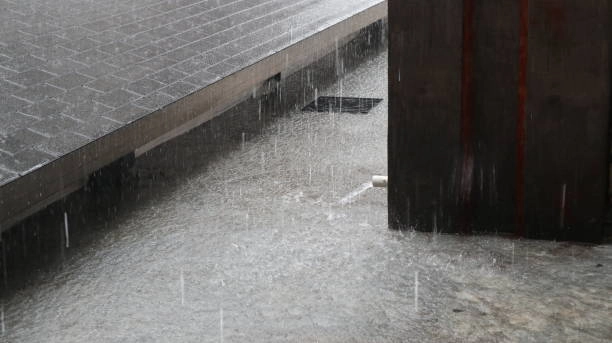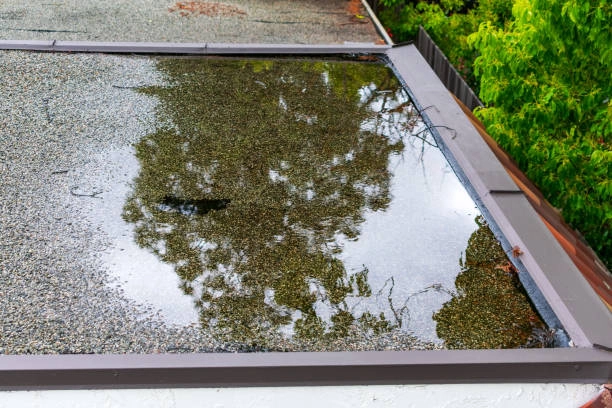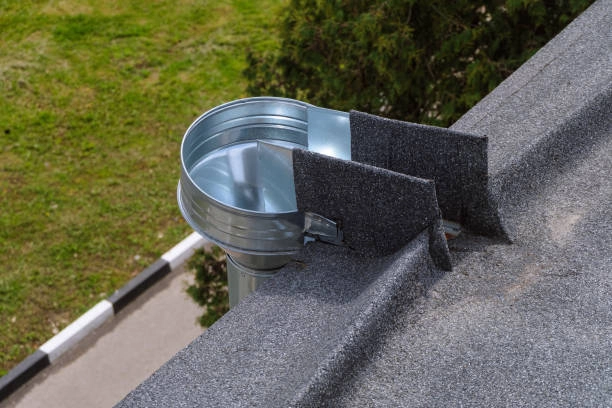Flat roofs are a popular choice for both commercial and residential buildings due to their modern appearance and functionality. However, one of the most significant challenges with flat roofing is ensuring proper drainage. Unlike sloped roofs, flat roofs rely on drainage systems to prevent water from pooling, which can lead to costly damage if not addressed. In this article, we’ll explore seven common flat roof drain problems and provide practical solutions to fix them.

7 Common Flat Roof Drain Problems
1. Ponding Water
The Problem:
Ponding water occurs when rainwater or melted snow collects on your flat roof, forming puddles that remain for more than 48 hours. This issue is often caused by an improper slope, clogged drains, or low spots on the roof. Over time, ponding water can weaken the roofing material, cause leaks, and lead to structural damage.
The Fix:
- Clean Drains: Ensure that all flat roof drain is free from debris such as leaves and dirt.
- Install Crickets: Roof crickets, made of rigid foam board, can be installed in low areas to redirect water toward drainage points.
- Re-Pitch the Roof: For severe cases, consider adding tapered insulation or re-pitching the roof to improve water flow.
2. Clogged Gutters
The Problem:
Flat roofs often depend on gutters to direct water away from the building. Over time, these gutters can become clogged with debris like leaves and twigs, causing water to overflow and pool on the roof.
The Fix:
- Regularly inspect and clean your gutters to ensure they are functioning properly.
- Install gutter guards to minimize debris buildup.
- If your building experiences heavy rainfall, consider adding additional gutters or downspouts for better drainage.
3. Blocked Scuppers
The Problem:
Scuppers are openings along the edges of flat roofs that channel water into downspouts or away from the building. When scuppers become blocked by debris or ice, they can’t effectively drain water, leading to pooling and potential leaks.
The Fix:
- Clear scuppers regularly to remove any obstructions.
- Install strainers or screens over scuppers to prevent debris from entering.
- In colder climates, use heat cables near scuppers to prevent ice blockages during winter.

4. Damaged or Missing Drain Covers
The Problem:
Drain covers are essential for preventing debris from entering internal drains. If these covers are damaged or missing, debris can clog the drainage system, leading to water accumulation on the roof.
The Fix:
- Replace damaged or missing drain covers immediately.
- Opt for high-quality strainers that fit securely over your drains.
- Schedule regular inspections to ensure all covers are intact and functioning.
5. Poor Drain Placement
The Problem:
If flat roof drain is improperly placed—such as being located in high spots rather than low points—they won’t effectively remove water. This can result in persistent ponding issues.
The Fix:
- Consult a professional roofer to evaluate your drain placement.
- Relocate existing drains to low points on the roof where water naturally collects.
- Add additional drains if necessary to improve overall drainage efficiency.
6. Improper Slope
The Problem:
Flat roofs aren’t completely flat—they should have a slight slope (typically 1/4 inch per foot) to allow water to flow toward drainage systems. If your roof lacks this slope or has settled unevenly over time, it can lead to standing water.
The Fix:
- Add tapered insulation during your next flat roof replacement to create a proper slope.
- For minor issues, use spray polyurethane foam (SPF) to fill in low areas and improve drainage.
- Re-pitch the entire roof if necessary for long-term performance.
7. Overflow During Heavy Rainfall
The Problem:
During periods of heavy rainfall, existing drainage systems may become overwhelmed, causing overflow and pooling on your flat roof. This issue is especially common in areas with frequent storms or inadequate drainage capacity.
The Fix:
- Install secondary drainage systems such as overflow scuppers or emergency drains.
- Increase the size of existing gutters and downspouts to handle larger volumes of water.
- Work with a professional roofer like Gleason Roofing to assess whether additional drainage solutions are needed for your specific climate conditions.
Why a Proper Flat Roof Drain Matters
Flat roofs rely entirely on efficient drainage systems since they lack the natural runoff capabilities of sloped roofs. Without proper drainage:
- Water pooling can lead to leaks and damage the roofing membrane.
- Structural integrity may be compromised due to prolonged exposure to standing water.
- Mold and mildew growth can occur inside the building due to leaks.
- Your building’s foundation might be at risk if water overflows near its base.
By addressing these common problems promptly, you can extend the lifespan of your flat roofing system and avoid costly repairs down the line.
Preventative Maintenance Tips for Flat Roof Drain
To keep your drain system functioning effectively:
- Schedule Regular Inspections: Check all drains, gutters, and scuppers at least twice a year—ideally before and after heavy rainfall seasons.
- Remove Debris Promptly: Clear leaves, dirt, and other debris from all drainage points during inspections.
- Monitor for Leaks: Look for signs of leaks inside your building (e.g., water stains) and address them immediately.
- Ensure Proper Slope: Verify that your roof has an adequate slope toward drainage points during routine maintenance checks.
- Hire Professionals: Work with experienced roofing contractors like Gleason Roofing for expert advice and repairs tailored to your specific needs.
Trust Gleason Roofing for Your Flat Roofing Needs
At Gleason Roofing, we understand how critical proper drainage is for maintaining the integrity of your flat roofing system. With over 50 years of collective experience serving Phoenix-area homes and businesses, our team is equipped to handle everything from minor repairs to full-scale flat roof replacement projects.

A proper flat roof drain is important for keeping your roof working well for a long time. Fixing common problems like standing water, blocked gutters, and the wrong slope can help avoid expensive damage and make your roof last longer.
At Gleason Roofing, we focus on flat roofing options that fit your needs. Whether you need help with drainage, repairs, or a full roof replacement, our skilled team is ready to assist. Don’t let drainage issues put your building’s safety and performance at risk. Reach out to us today for expert advice and good service!
Frequently Asked Questions
1. What leads to drainage issues on flat roofs?
Flat roofs can have drainage problems because of the wrong slope, blocked drains, bad drain placement, and flat roof drain issues. These problems can cause water to pool, which can damage the roofing and reduce its lifespan. Regular roof maintenance can help minimize these issues.
2. Are flat roof tiles good for stopping drainage issues?
Flat roof tiles are usually not the best option for flat roofs. They can hold water if they are not installed correctly. Instead, materials such as TPO, EPDM, and PVC are often used. These materials help water run off and lower the chance of water gathering.
3. How do clogged gutters affect flat roofing?
Clogged gutters can make water back up and settle on flat roofs. This raises the chance of leaks and water damage. Regularly cleaning your gutters and using gutter guards can help keep the system clear and working well.
4. What care is suggested for flat roof drain?
To keep flat roofing drains in good shape, check them often and remove debris from scuppers, drain covers, and gutters. Put strainers in place to stop blockages. Also, plan inspections before and after heavy rain to make sure water is draining well.
5. Why is a proper slope important in flat roofing?
Flat roofing needs a small slope (about 1/4 inch per foot) so water can move toward drainage points. If there isn’t a good slope, water can gather around the flat roof drain, causing standing water and damage to the roof. Adding tapered insulation when replacing a roof can help with drainage.
6. What can I do if my flat roof is holding water?
If your flat roof is collecting water, you should think about cleaning the flat roof drain, adding slants to direct the water, or changing the roof’s angle. Putting in extra drainage systems, like overflow scuppers, can help control heavy rain. Talking to a professional can help you find the best solution.
7. How can I stop water from collecting on my flat roof?
To stop water from collecting, make sure your flat roof has flat roof drain in the right spots, gutters that work well, and a good slope. Regular checks and care, like cleaning debris from flat roof tiles, gutters, and outlet areas, are important for good water flow.
